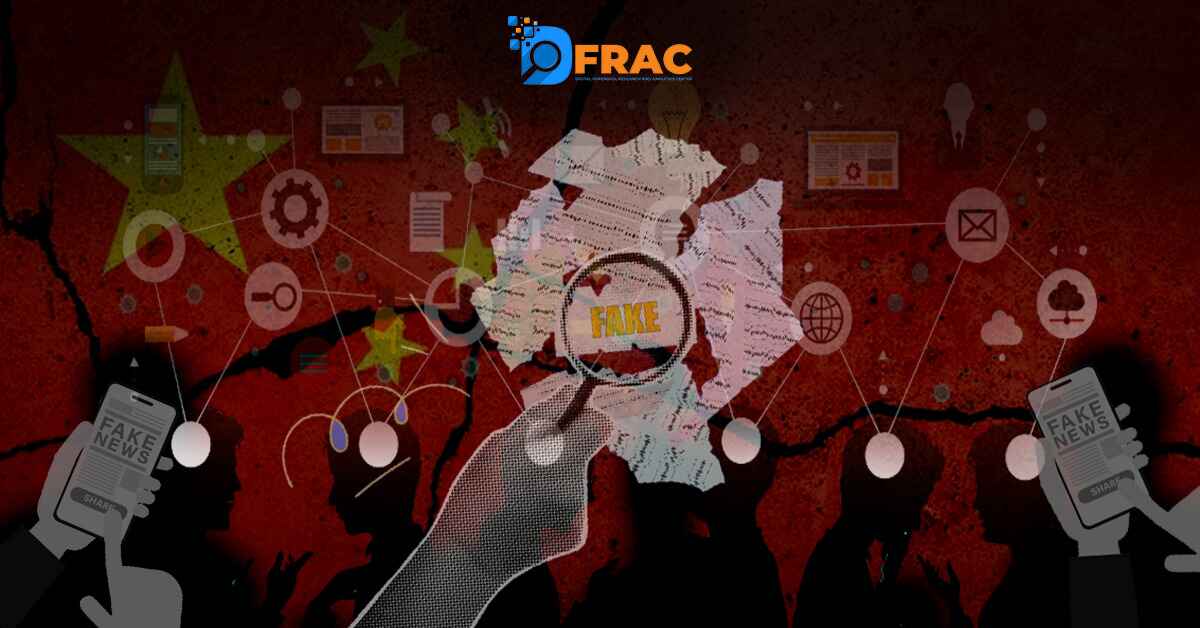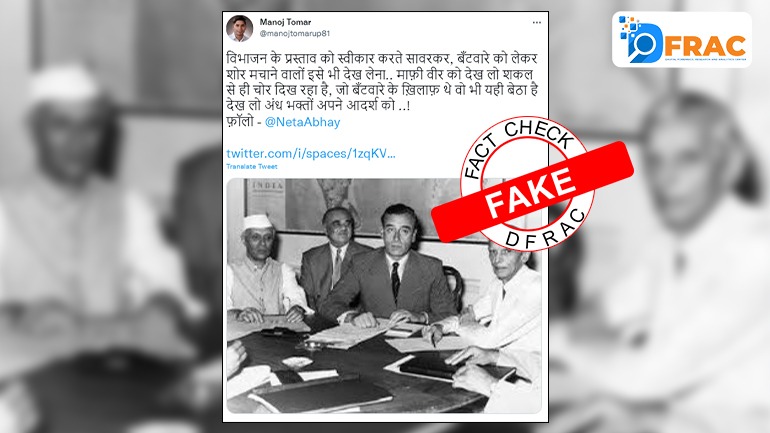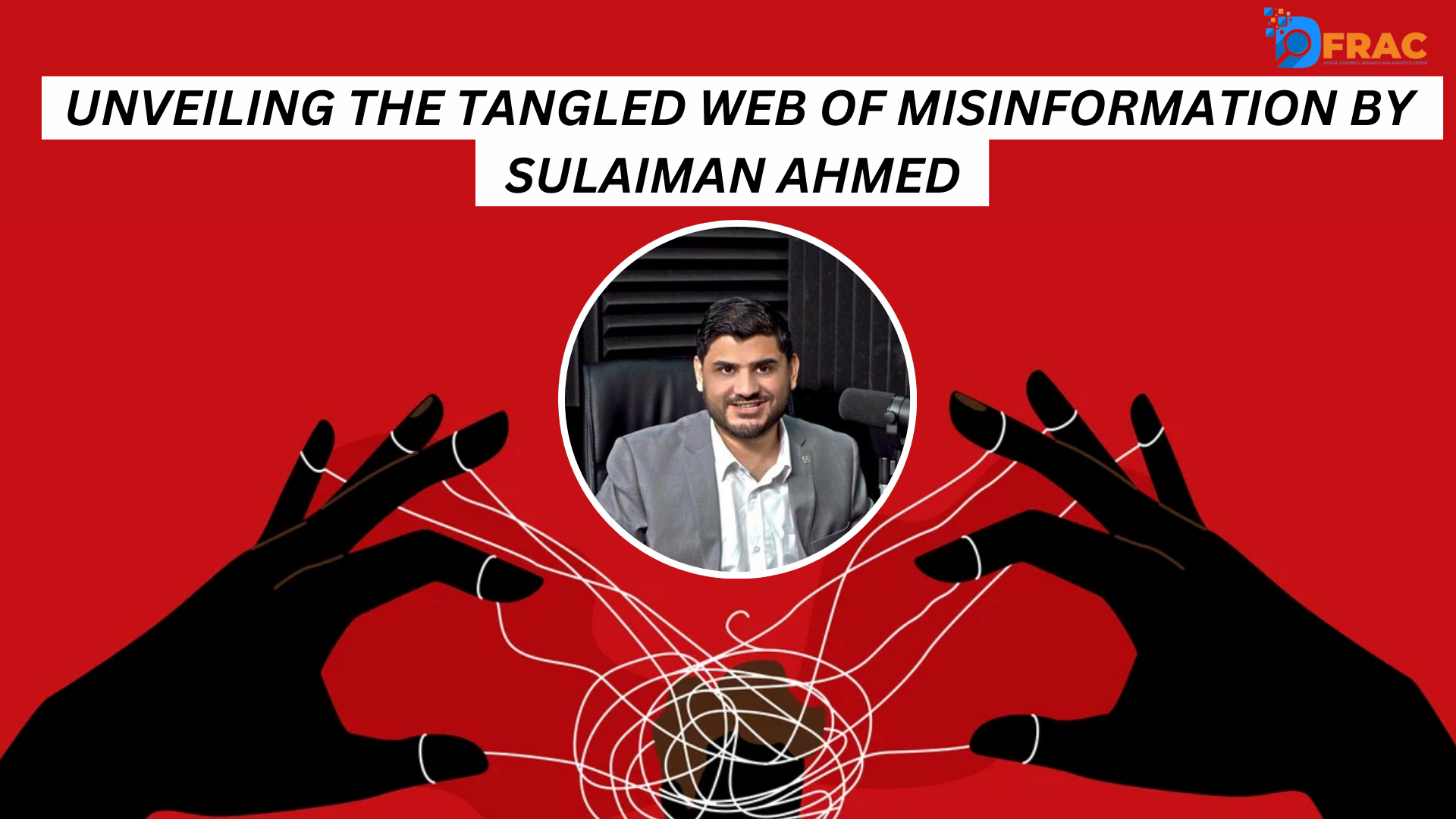In the tense aftermath of the Pahalgam terror attack and India’s retaliatory strikes on May 7, 2025, Chinese social media became a tightly controlled arena for messaging that both vindicated Pakistan and cast India as the aggressor. By analyzing Weibo threads, Twitter posts, state-affiliated influencers, and commentary sites, we uncover a coordinated disinformation campaign designed to shape domestic perceptions in China, bolster Pakistan’s diplomatic position, and undermine India’s international standing.
Table of Contents
- Executive Summary
- Phase One: Initial Response Campaign Following Pahalgam Attack
2.1 Strategic Hashtag Coordination
2.2 Multi-Layered Narrative Construction - Phase Two: Escalation Following Indian Military Response
3.1 Systematic Disinformation Campaign
3.2 High-Profile Influencer Amplification - Phase Three: Military Superiority Narrative Campaign
4.1 Comprehensive Media Ecosystem Mobilisation
4.2 Facebook Military Analysis Propaganda
4.3 Exaggerated Military Capability Claims - Phase Four: State Media Amplification and Sentiment Analysis
5.1 Strategic Integration of Official Chinese Media Narratives
5.2 Quantitative Sentiment Analysis Results
Executive Summary
This comprehensive analysis examines a sophisticated, multi-platform information warfare campaign orchestrated by Chinese users and state-aligned influencers during the India-Pakistan tensions following the Pahalgam attack in May 2025. The investigation reveals a coordinated effort spanning Twitter, Weibo, Facebook, and various Chinese media platforms, designed to undermine India’s credibility while amplifying pro-Pakistan narratives and showcasing Chinese military superiority.
The campaign demonstrates several hallmarks of organized information warfare: coordinated hashtag usage, synchronized messaging across platforms, amplification by high-engagement accounts, and the systematic spread of both authentic content and deliberate disinformation. Understanding this campaign provides crucial insights into how modern information warfare operates in the digital age, particularly in the context of regional geopolitical tensions.
Phase One: Initial Response Campaign Following Pahalgam Attack
Strategic Hashtag Coordination
The campaign began immediately following the Pahalgam attack (22 April, 2025) with the deployment of carefully crafted hashtags designed to frame the narrative in ways favorable to Pakistan while undermining India’s response. The primary hashtags #ModiInterruptsHisVisitAndReturnsHomeUrgently” and “#PakistanSuspendsAllTradeWithIndia” were strategically chosen to portray Modi’s return to India as a sign of panic or weakness, while simultaneously presenting Pakistan’s economic measures as justified responses to Indian aggression. The hashtags also served as coordination mechanisms, enabling distributed users to contribute to a unified narrative without centralised control.
Multi-Layered Narrative Construction
The initial phase employed three distinct but interconnected narrative strategies. The first involved historical deflection, where Chinese users attempted to reframe the discussion by raising counter-accusations about India’s alleged support for the Balochistan Liberation Army. This approach follows a classic disinformation technique of “whataboutism,” designed to muddy the waters and prevent focused discussion of the immediate incident.
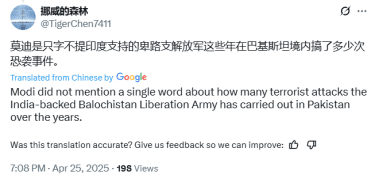
The second narrative layer focused on water diplomacy, transforming a security incident into a humanitarian crisis narrative. Chinese users claimed that India was weaponizing water resources against Pakistani civilians, stating that India would “cut off Pakistan’s vital water source, and then open floodgates to inundate Pakistani farmland, causing floods in 50 villages and affecting millions of people.” This narrative served multiple purposes: it shifted focus away from the terrorist attack, portrayed India as an aggressor against civilians, and aligned with China’s broader regional interests regarding water resources in South Asia.
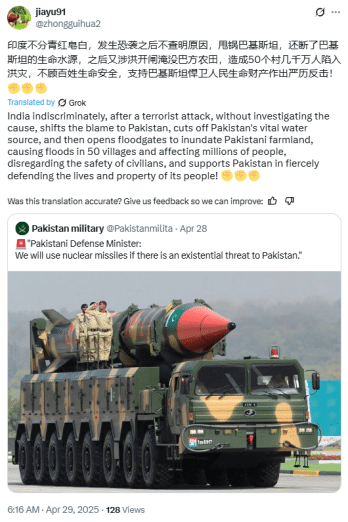
The most concerning element was the third narrative layer, which promoted elaborate conspiracy theories suggesting the attack was a false flag operation. Users claimed that “Modi, to align with the U.S. conspiracy, orchestrated a large-scale terrorist attack and framed Pakistan for it.” This reflected Pakistan’s stance on India’s false flag narrative, which we have debunked earlier in detail here.
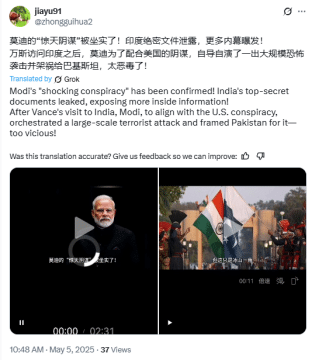
Platform-Specific Messaging Adaptation
The campaign demonstrated a sophisticated understanding of different platform audiences by adapting messaging styles while maintaining core narrative consistency. On Weibo, targeting Chinese domestic audiences, the messaging included more direct cultural insults and references to specific infrastructure projects like the Motuo Hydropower Station. Chinese users wrote comments such as “India regards the most basic and ordinary morality of human beings as worthless” and used derogatory terms while calling for accelerated Chinese infrastructure development.
On Twitter, targeting international audiences, the messaging focused more on geopolitical arguments and international law claims, while frequently amplifying official Pakistani accounts to create an impression of broader international support for Pakistan’s position.
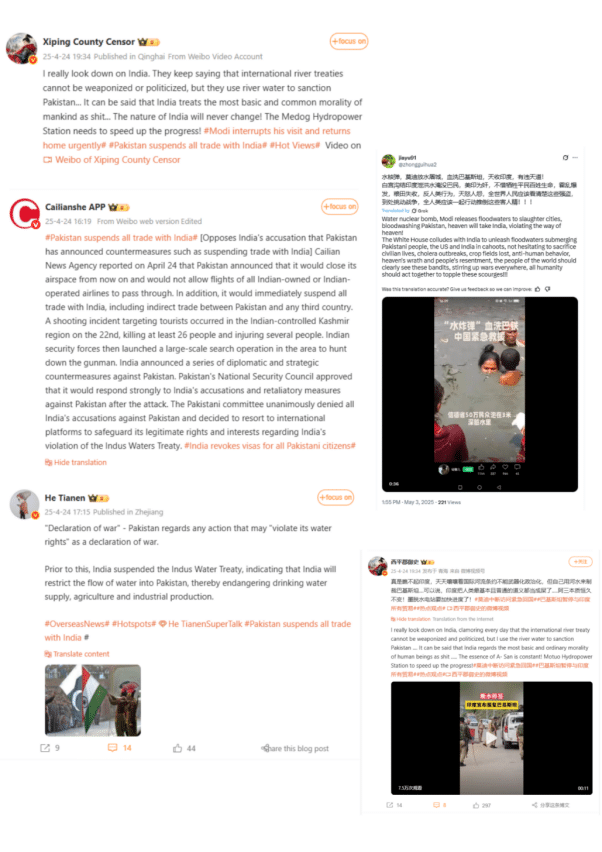
Phase Two: Escalation Following Indian Military Response
Systematic Disinformation Campaign
After India’s military response on May 7, the campaign escalated significantly with the introduction of more sophisticated disinformation tactics. Chinese users began spreading false claims that India was “the first to bomb Pakistan and refused international participation in the investigation of the terrorist attack,” while promoting conspiracy theories that “this terrorist attack was supported by India itself.”
The disinformation became more elaborate, with users claiming that terrorist organizations themselves had “jumped out and said it was not me, and provided documents that the Indian government planned this false flag incident.” This represents a particularly insidious form of disinformation because it attempts to use the denial of responsibility by terrorist groups as evidence of Indian complicity, inverting normal logical reasoning. These posts drew heavy attention. State-media tweets often garnered thousands of likes/shares before being deleted or blocked in India (e.g. Global Times’ disinformation tweet prompted removal). For instance, Xinhua’s English casualty report (May 7) was widely reposted. Weibo content also saw hundreds of interactions: one pro-Pakistan Weibo update had ~500 likes and 150+ reposts.
Hashtags & trends: Weibo used Chinese tags to frame the conflict. The hashtag #印巴冲突 (India-Pakistan conflict) trended on several days, often attached to commentary mocking India or praising Pakistan. Other frequent tags included #巴基斯坦绝不容忍 (“Pakistan will not tolerate [aggression]”) and general geopolitical labels like #中巴友谊 (China-Pakistan friendship). By contrast, English hashtags were rare on Weibo; discussions stayed in Chinese.
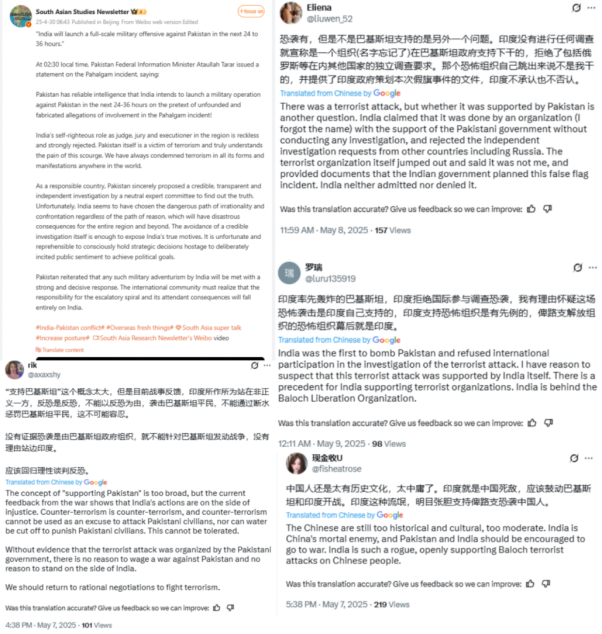
High-Profile Influencer Amplification
The second phase saw the emergence of specific high-engagement accounts that served as amplification nodes for the broader campaign. Three accounts in particular played crucial roles in spreading sophisticated disinformation while maintaining the appearance of independent commentary.
- The account @YinZP365 specialized in military analysis, designed to undermine India’s credibility while promoting Chinese and Pakistani military capabilities. On May 20, 2025, this account mocked India’s military strategy, claiming Modi employed a “turn defeat into victory” approach designed to “brainwash Indian people, boost morale, and hinder the development of China’s military industry.” The account combined legitimate-sounding military analysis with speculative claims, such as rumors about Pakistan ordering 40 J-35 fighters, while provocatively asking whether viewers would see a “Battle of New Delhi” in the future.
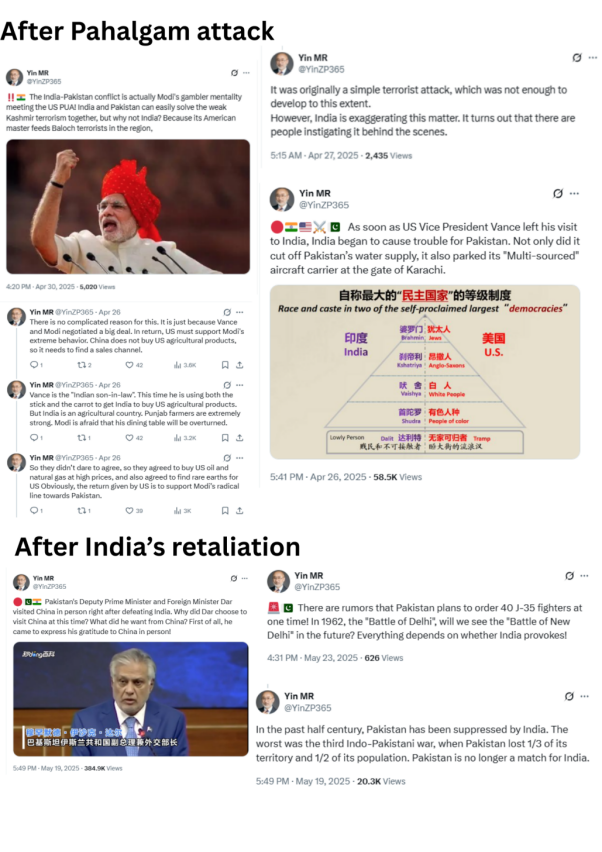
2. The @zhao_dashuai account focused on spreading more direct disinformation, including false claims about Indian atrocities against Pakistani civilians. On May 21, 2025, this account posted fabricated claims that “an Indian news channel was gloating about a terrorist attack orchestrated by India, killing four Pakistani children and two adults.” The account accompanied these claims with videos that were later debunked as unrelated to the claimed incidents. This represents a particularly concerning form of disinformation because it combines emotional manipulation through claims about child victims with multimedia “evidence” that appears credible at first glance.
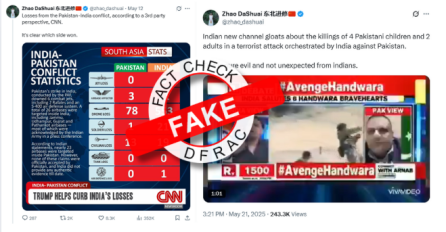

3. The @shen_shiwei account specialized in military disinformation, making false claims about Pakistani military successes during Indian operations. On May 7, 2025, this account claimed Pakistan had shot down multiple Indian jets, including “three Rafale fighters, one MiG, and one Su-30,” along with 12 Indian drones. These claims were comprehensively debunked by India’s Press Information Bureau, which clarified that no such losses occurred and that images used were from unrelated incidents, such as a 2021 MiG-21 crash in Punjab.
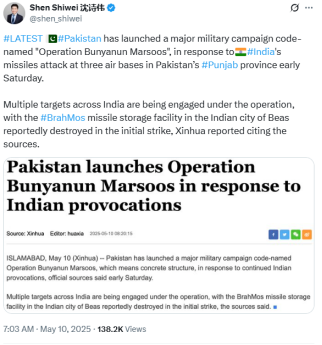
Phase Three: Military Superiority Narrative Campaign
Comprehensive Media Ecosystem Mobilisation
The third phase of the campaign expanded beyond social media to include traditional Chinese media outlets and personal blogging platforms. This expansion suggests either direct state coordination or at minimum, tacit approval from Chinese authorities, as major Chinese media platforms typically exercise strict content control.
China.com reported false claims that “Pakistan destroyed a BrahMos missile storage facility in India,” while Tianjin Daily published comparative analyses of Indian and Pakistani air forces designed to conclude that neither could achieve “decisive victory” against the other.

Narrative Analysis of Tianjin article: The article from Tianjin Daily dated May 9, 2025, presents a predominantly negative sentiment towards India. It portrays India as an aggressor in the recent escalation with Pakistan, following the Pahalgam attack. The piece emphasizes India’s military actions as provocative and unjustified, while casting doubt on India’s claims regarding the attack’s perpetrators. Furthermore, it highlights Pakistan’s responses as defensive and measured, suggesting that India’s actions are destabilizing regional peace. The article also underscores China’s support for Pakistan, framing it as a stabilising force in contrast to India’s alleged belligerence. Overall, the narrative aligns with China’s strategic interests, reinforcing a pro-Pakistan and anti-India stance.
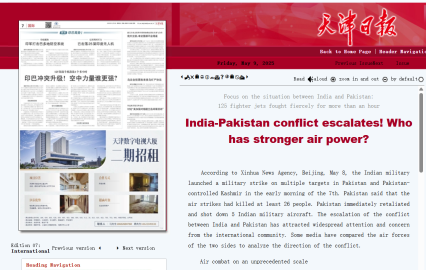
The Guancha platform went further, actively celebrating the supposed superiority of Chinese weapons systems, claiming that Chinese-supplied equipment like “the J-10C fighter jet, PL-15E missile and HQ-9 air defense system outperformed India’s weapons systems and reflect the strength of China’s technological and industrial strength.”
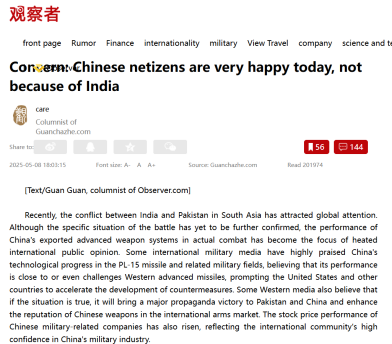
Facebook Military Analysis Propaganda
On Facebook, the campaign included detailed military analysis designed to showcase Chinese training and equipment superiority. Users promoted narratives claiming that “under Chinese training, India has no easy victory over Pakistan in air combat” and that Pakistan had been given superior “air combat tactics” that represented “only a small test with a weak strike.”
The Facebook content revealed particular sophistication in military technical knowledge, discussing concepts like “finding first shoot down” tactics and the role of early warning aircraft in missile guidance. Users claimed that “the Pakistani fighter is already a launcher. The early warning aircraft guiding the missile to the target is the key to deciding the victory or defeat.”
Perhaps most revealing was content that explicitly framed the conflict in terms of Chinese strategic interests, with users claiming that “through this battle, the Chinese side achieved the goal of fighting bulls and knocking the tiger.” This metaphorical language suggests that Chinese strategists viewed the India-Pakistan conflict as an opportunity to test and demonstrate Chinese military capabilities while weakening India’s regional position.
Exaggerated Military Capability Claims
The campaign included increasingly exaggerated claims about Chinese military superiority, with Facebook users claiming that Pakistan “fought India with the purchase of J10 fighter jets eliminated by China, shot down 6 Indian fighter jets. In just 30 minutes, it got a record of 6:0.” These users then extrapolated these false claims to promote broader Chinese military capabilities, asking rhetorically how much more powerful newer Chinese aircraft like the “J15, J16, J20, J35, J36, J50” would be compared to the supposedly successful J10.
This progression from false battlefield claims to broader military superiority narratives demonstrates how information warfare campaigns can use immediate events as launching points for longer-term strategic messaging about regional power balances.
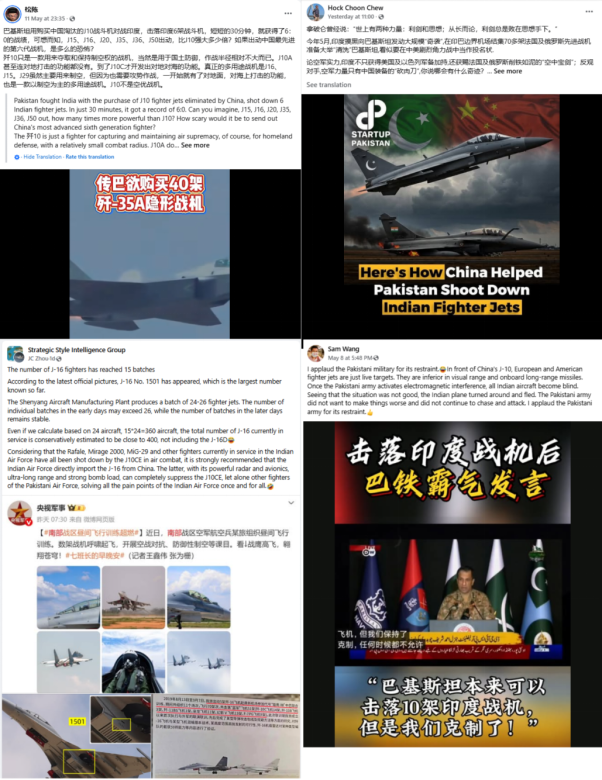
Phase Four: State Media Amplification and Sentiment Analysis
Strategic Integration of Official Chinese Media Narratives
The information warfare campaign’s sophistication becomes even more apparent when we examine how official Chinese state media outlets coordinated their coverage with the grassroots social media activities. During the critical period of India-Pakistan tensions, three major Chinese state media organizations – Global Times, China Military, and CGTN (China Global Television Network) – published content that aligned strategically with the social media narratives while maintaining the veneer of legitimate journalistic coverage.
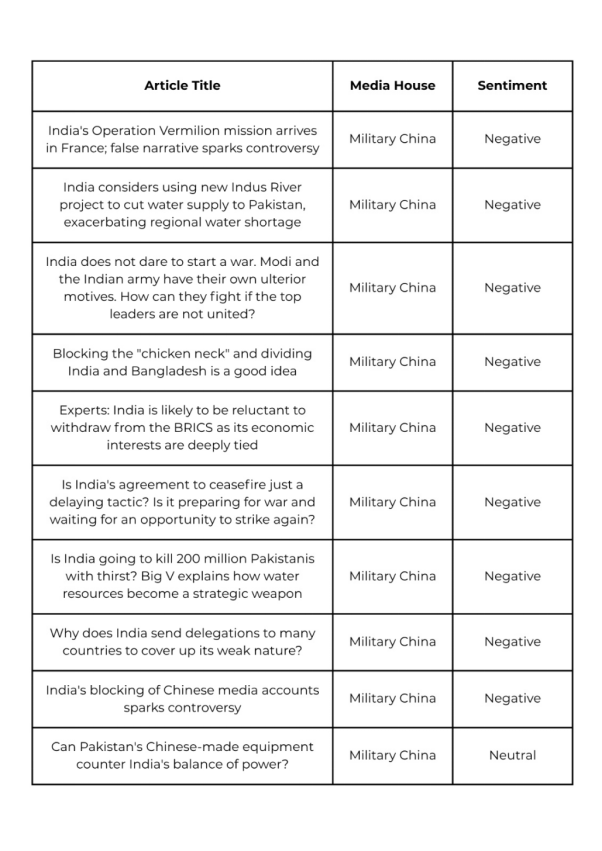
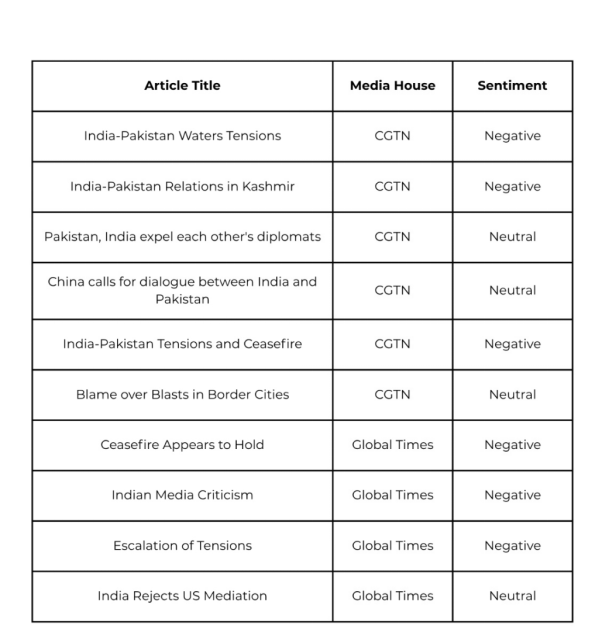
Below we show the graphical representation of the articles’ sentiments published in Chinese state media against India. The sentiment analysis of articles from CGTN, Global Times, and China Military during the India-Pakistan tensions reveals systematically negative coverage of India across all three major Chinese state media outlets. The graphical representation demonstrates consistent anti-India bias, with articles portraying India as the primary aggressor while presenting Pakistan as a victim of Indian provocation.
CGTN articles showed predominantly negative sentiment toward India’s military actions and diplomatic positions, while simultaneously promoting narratives that aligned with Pakistani official statements. Global Times coverage amplified conspiracy theories about Indian false flag operations and questioned India’s credibility in international forums. China Military publications focused specifically on undermining confidence in Indian military capabilities while promoting the superiority of Chinese-supplied Pakistani equipment.
- CGTN Articles

2. Global Times article
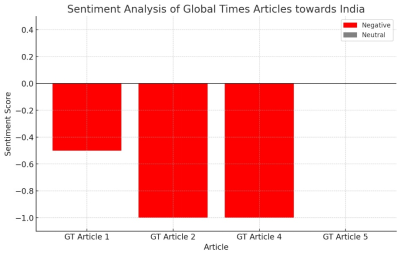
Military China Articles
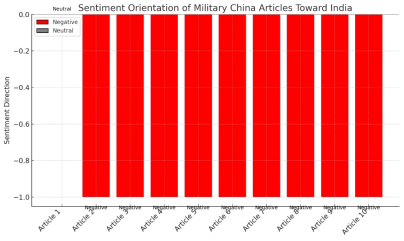

Conclusion
The timing and coordination of this campaign reveal China’s opportunistic approach to South Asian conflicts. Rather than seeking to de-escalate India-Pakistan tensions, Chinese information operations actively amplified the crisis to advance Beijing’s strategic objectives. The campaign used the Pahalgam attack as a launching point for broader narratives about Indian aggression, Pakistani victimhood, and Chinese military superiority.
India faces an adversary that has weaponized the entire Chinese digital ecosystem against Indian interests. The coordination between grassroots social media users, high-engagement influencers, and state media outlets creates an information warfare infrastructure that can be rapidly mobilized during any crisis involving India.
India must recognize that Chinese information warfare operations will intensify as strategic competition deepens. The sophistication demonstrated in this campaign – from coordinated hashtag deployment to multilingual platform adaptation to technical military disinformation – represents capabilities that will be deployed again in future crises.


